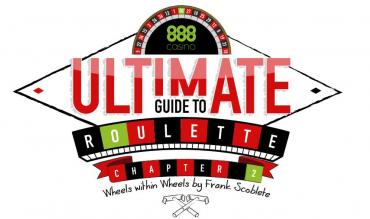Updated on April 10 2025
Written by casino specialist, Frank Scoblete, this comprehensive beginner's guide on how to play roulette focuses on the rules, bet types, house edge odds and chances of winning. All essential aspects of the game are explained from changing money into playing chips to how gambling sessions end.
Roulette stands as one of the most recognizable casino games in the world. Its spinning wheel and bouncing ball have become symbols of casino gaming itself. While the game appears simple at first glance, understanding its nuances can significantly enhance your playing experience and potentially improve your chances of walking away a winner. This guide will take you through everything you need to know about playing roulette, whether you're a complete novice or looking to refine your strategy.
The Basic Rules When Playing Roulette
The thrill of the spinning wheel and the bouncing ball has made roulette one of the most iconic casino games worldwide. Whether you're planning to enjoy roulette at 888 Casino or any gaming establishment, understanding the fundamentals is crucial.
How a Round of Roulette Unfolds
The game starts with players making bets by placing chips on the roulette table layout. This layout features all the numbers and betting propositions available. After providing sufficient time for players to place their wagers, the game proceeds to the exciting moment of the spin.

The roulette croupier (dealer) then follows this sequence:
- Turns the roulette wheel in the opposite direction it last rotated;
- Sends the ball spinning into the wheel's ball track in the opposite direction;
- Allows players to continue placing bets during the early stages of the spin;
- Announces "No more bets" as the ball slows down and begins to fall toward the numbered pockets.
This procedure is an important rule aimed at generating a high degree of randomness that makes predicting outcomes extremely difficult. Dealers can also vary the speed of a wheel and ball. The harder they propel a ball the more revolutions it will make.
Determining the Outcome
When the ball eventually loses momentum, it bounces among the pockets before settling into one numbered slot. Previous outcomes will be displayed on a results board. Around sixteen numbers on a display at a wheel in a land-based casino and normally more when playing online.
If there are winners who bet the number, a section or color the number is part of, they will be rewarded according to the payout odds.
Payout time is included in the rules of how to play roulette. So, you should know when you should be paid if you win. The dealer will place a dolly marker on top of the winning number on the table layout and proceed to pay out any winners. Online players will be paid automatically with the credit amount appearing in their balance.
This rhythm of bet-spin-payout creates the characteristic flow of the roulette game that has captivated players for generations.
How to Play Roulette - Types of Roulette Bets
Learning how to play roulette effectively requires understanding the variety of bets available. The roulette table layout offers numerous betting options, each with its own risk profile and potential reward.
To begin playing roulette, players exchange money for chips, then place bets on numbers or propositions:
- Inside bets are placed directly on one or more numbers
- Outside bets are placed on certain propositions such as high/low, odd/even, red/black, dozens, etc.
The distinction between these two categories is important, as they represent different approaches to playing roulette. Inside bets offer higher payouts but lower probabilities of winning, while outside bets provide more frequent wins but with smaller payouts.
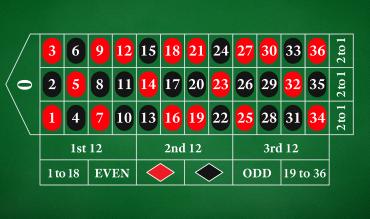
Click here for a complete guide to roulette odds.
Wheel Design and Number Arrangement
Let’s take a quick look at how the numbers are arranged on the roulette wheel. The numbers are well distributed rather than in numerical order. This arrangement was originally designed to prevent players from easily spotting wheel biases.
On the American wheel, you'll notice that directly (or almost directly) across from each even number is typically an odd number. Similarly, pairs of odd numbers alternate with pairs of even numbers except in the areas of the numbers 0 and 00. The design is intentional to create a balanced visual appearance while maintaining the randomness of outcomes.
Inside Bets
THE STRAIGHT UP (French: En Plein)
You bet one or more numbers by placing your bet on that or those numbers on the layout. If your number or one of your numbers is the outcome of the game you win 35 to 1 on that number.
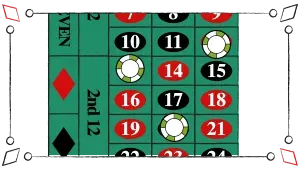
SPLIT BET (French: A Cheval)
This bet is placed on more than one number by placing your chip(s) on the line between two numbers. The payoff if either number hits is 17 to 1.
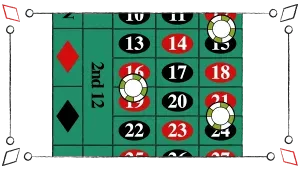
THE STREET BET (French: Transversal)
Street bet roulette betting rule: You make a street bet by placing your chips on the outside border of the three numbers. A winning bet pays off at 11 to 1.

THE CORNER BET (French: Carre)
Bet on four numbers that form a square by placing your chip at the intersection where all four numbers meet. Pays 8 to 1.
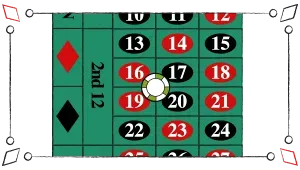
THE FIVE NUMBER BET (AKA ‘The Monster’ or ‘The Beast’)
Found only on American wheels, this bet covers 0, 00, 1, 2, and 3. It pays 6 to 1 but carries the highest house edge (7.89%) of any roulette bet. Avoid this bet if possible.
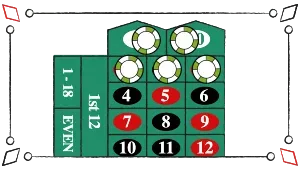
THE SIX LINE BET (French: Sixain)
Place your chip on the outside borders of two adjacent rows, covering six numbers. Pays 5 to 1.
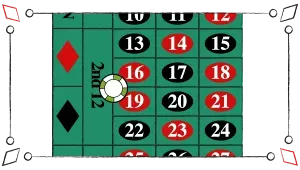
Outside Proposition Bets
THE COLUMN BET (French: Colonne)
You are wagering that the set of numbers forming one of the columns on the layout will have the winning number. Bet on one of the three columns of numbers on the layout. Place your chip at the bottom of the column. Pays 2 to 1.

THE DOZENS BET (French: Douzaine)
The bet is whether one of a dozen numbers on the layout will hit. Bet on the first (1-12), second (13-24), or third (25-36) dozen numbers. You’re allowed to bet in more than one dozen. Pays 2 to 1.
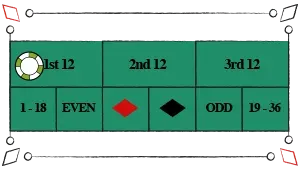
THE ODD OR EVEN BET (French: Impair et Pair)
Bet on whether the winning number will be odd or even. Pays even money (1 to 1).
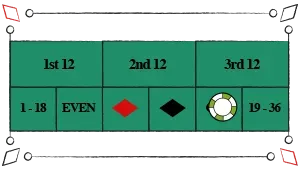
HIGH OR LOW BET (French: Passe et Manque)
This bet is placed on either the 1 to 18 or the 19 to 36 section of the layout. Pays even money.
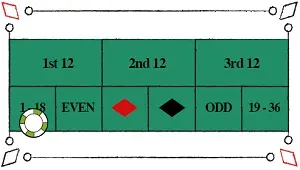
RED OR BLACK BET (French: Rouge et Noir)
Bet on whether the winning number will be red or black. Pays even money.
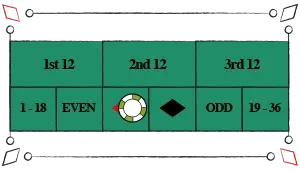
NOTE: Each one of the proposition bets loses if 0 or 00 shows.
The Roulette Scoreboards and Betting Trends
Modern roulette tables, especially in high-end casinos and at platforms like 888 casino roulette, feature electronic scoreboards that display previous results, usually showing the last 16 to 20 numbers. Some advanced casinos even have scoreboards that can show results from all roulette tables being used in the establishment.
These scoreboards serve two main purposes:
- They allow players who couldn't see the actual spin to verify the outcome
- They enable trend bettors to identify patterns they believe might continue
Many players analyze these boards looking for "hot" numbers (those appearing frequently) or "due" numbers (those that haven't appeared for a while). However, it's important to understand that each spin of the roulette wheel is an independent event. The ball has no memory of previous spins, and mathematically, every number has exactly the same probability of appearing on each spin regardless of history.
Still, tracking results is part of the fun of playing roulette, and many players enjoy developing their own systems based on these observations. Just remember that no betting system can overcome the mathematical house edge in the long run.
Understanding the House Edge in Roulette
The house edge is what gives casinos their advantage. Knowing this edge helps you make smarter decisions when playing roulette:
American vs. European Roulette
- American roulette wheels have 38 numbers (1-36, 0, and 00) with a standard house edge of 5.26%
- European roulette wheels have 37 numbers (1-36 and 0) with a standard house edge of 2.7%

The European game is superior for players. The difference comes from the payout structure – a winning bet pays 35 to 1, but the true odds would be 37 to 1 on American wheels and 36 to 1 on European wheels.
How the House Edge Affects Your Bankroll
What does this mean for your wallet? On the American wheel, you can expect to lose about 5.26 units for every 100 units wagered. On the European wheel, that drops to about 2.7 units per 100 wagered. This significant difference explains why experienced players always prefer European wheels when available.
To illustrate this difference more clearly, if you were to wager $100 during an evening of roulette, your expected loss would be approximately $5.26 on an American wheel, but only $2.7 on a European wheel. Over time, this difference becomes substantial.
Here’s a handy dandy chart of the units concerning the various bets in roulette:
| Bet/Wheel | House Edge % | Expected Loss per 100 Units |
|---|---|---|
| 5-Number Bet / American | 7.89% | 7.89% |
| All Other Bets / American | 5.26% | 5.26% |
| All Bets / European | 2.7% | 2.7% |
| Even Money Bets w/ Surrender / American | 2.63% | 2.63% |
| Even Money Bets w/ En Prison / European | 1.35% | 1.35% |
The Mathematics Behind the Edge
The house edge is calculated by looking at the difference between the true odds and the payout odds. The American wheel has 38 numbers and the payment for a winning bet is 35 to 1. In a fair game, one where the casino doesn’t have the edge, the payout for the winning bet should be 37 to 1. In short, you bet 1 and you win 37. So, you’ll lose 37 times but win once and the game is even; there is no edge for either the player or the casino. That is zero percent.
- On an American wheel (38 numbers), the winning bet should be 37 to 1. In short you’d bet 1 and win 37. So the game would be even if you won once in 38 rounds.
- On a European wheel (37 numbers), the winning bet should be 36 to 1. The game would be even if you won once in 37 rounds.
But both versions pay only 35 to 1 for a winning straight-up bet.
This difference represents the house advantage.
Reducing the House Advantage
Smart roulette players look for ways to minimize the house edge. Two special rules can help cut the advantage in half.
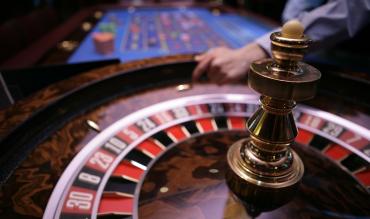
The following rules make even-money bets significantly more attractive. If you're playing at a table that offers either, consider focusing your strategy on these outside bets:
SURRENDER
Available at some casinos, surrender applies to even-money bets (red/black, odd/even, high/low). If the ball lands on 0 or 00, you only lose half your bet instead of the entire amount. This reduces the house edge from 5.26% to 2.63% on American wheels and from 2.7% to 1.35% on European wheels – one of the best wagers in the casino!
EN PRISON
Found mainly in European casinos, this rule applies when the ball lands on 0. Your even-money bet is neither won nor lost but "imprisoned" for the next spin. If your bet wins on the next spin, you get your original stake back (not a win). If it loses, you lose your stake. This also reduces the house edge to 1.35%.
How to Play Roulette at a Casino: Practical Tips
Getting Those Roulette Chips
In many casinos, roulette uses special colored chips different from those at other table games. When you approach a roulette table:
- Place your money on the table between decisions;
- Ask for “colors” or any available color chips;
- Tell the dealer how much you want each chip to be worth (if different from the table minimum);
- The dealer will record this value and give you your chips.
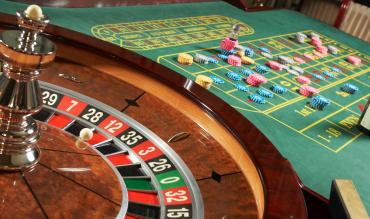
When to Bet
Wait until the dealer removes the marker from the previous winning number. This signals that betting for the next round can begin. If you can't reach where you want to place a bet, politely ask the dealer to place it for you.
The dealer will spin the wheel while bets are being made, but at a certain point, will wave a hand over the layout and say, "No more bets." After this announcement, no additional bets are permitted.
Winning and Losing
When a number hits, the dealer announces it, places the marker on that number, and removes all losing bets. Then all winning bets are paid. No betting can occur while the marker is on the layout. Once winners are paid and the marker is removed, the next round of betting begins.
Final Thoughts on Playing Roulette
Roulette has been captivating players for centuries with its elegant simplicity and exciting possibilities. When you understand how to play roulette properly, it becomes less intimidating and more enjoyable. Remember these key points:
- Always look for European single-zero wheels when possible;
- Take advantage of surrender or en prison rules if available;
- Avoid the five-number bet on American wheels (“The Beast");
- For best odds, stick primarily to outside bets;
- Manage your bankroll and set win/loss limits;
- Don't chase losses – set a budget and stick to it;
- Remember that each spin is independent of previous spins;
- Enjoy the experience rather than focusing solely on winning.
Playing roulette is about entertainment as much as it is about the possibility of winning. The game's enduring popularity comes from its perfect balance of simplicity and depth, providing both casual players and serious gamblers with an engaging experience.
And whatever you do, remember that casino roulette is infinitely preferable to Russian roulette – in one game, the worst outcome is losing your chips; in the other... well, let's just say the house edge is considerably more permanent! So forget about how to play russian roulette casino and stick to the traditional game.
Whether you're playing at 888 casino roulette or at a land-based venue, these principles will serve you well. The wheel spins, the ball bounces, and with a little knowledge and a lot of luck, you might just walk away a winner. The beauty of roulette lies in its combination of chance, strategy, and the timeless thrill of watching that small white ball determine your fortune.
Originally published in 2016 and updated in 2025 by Frederico Pereira
